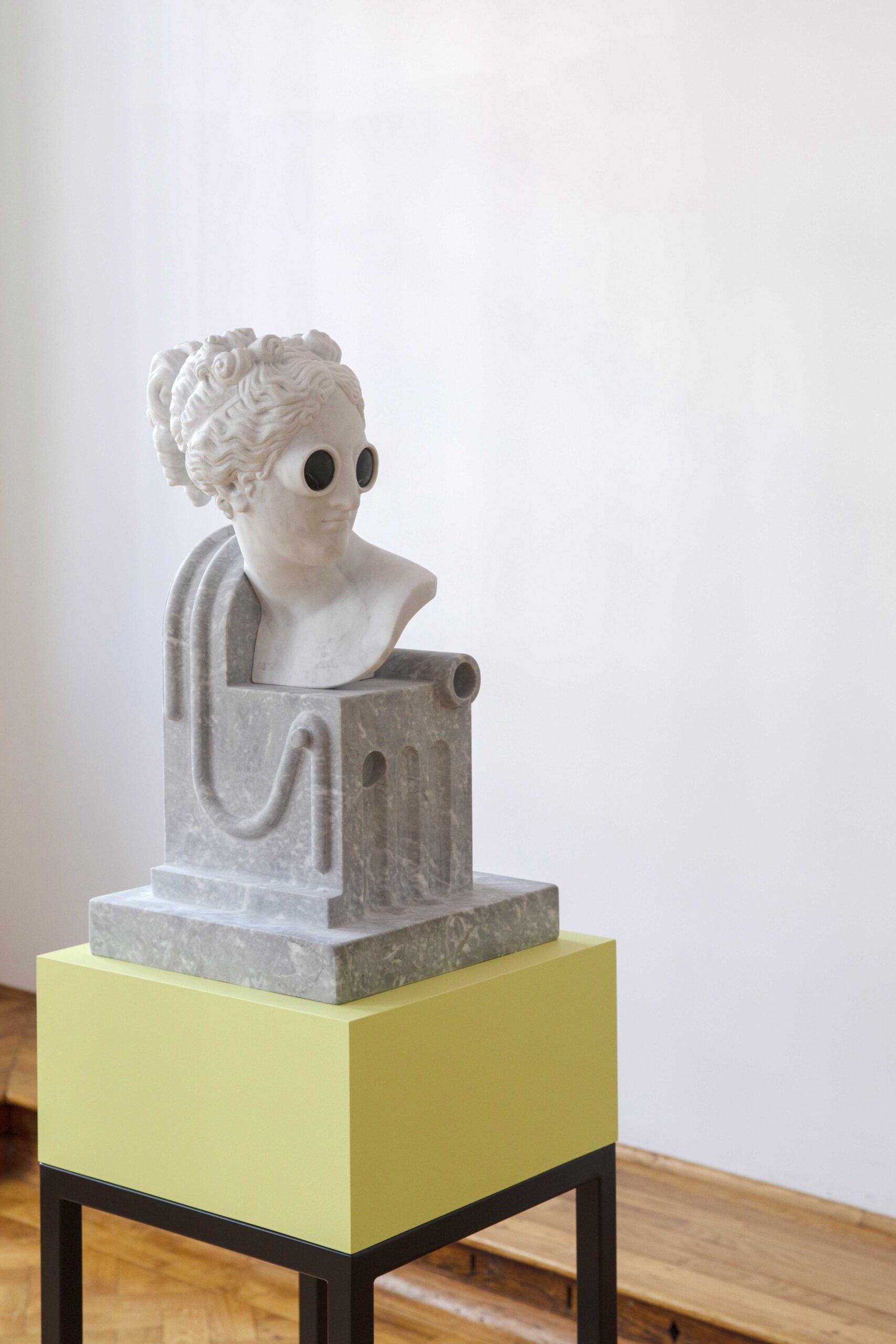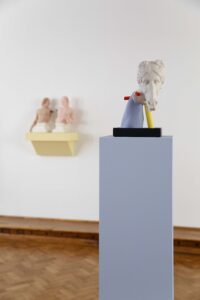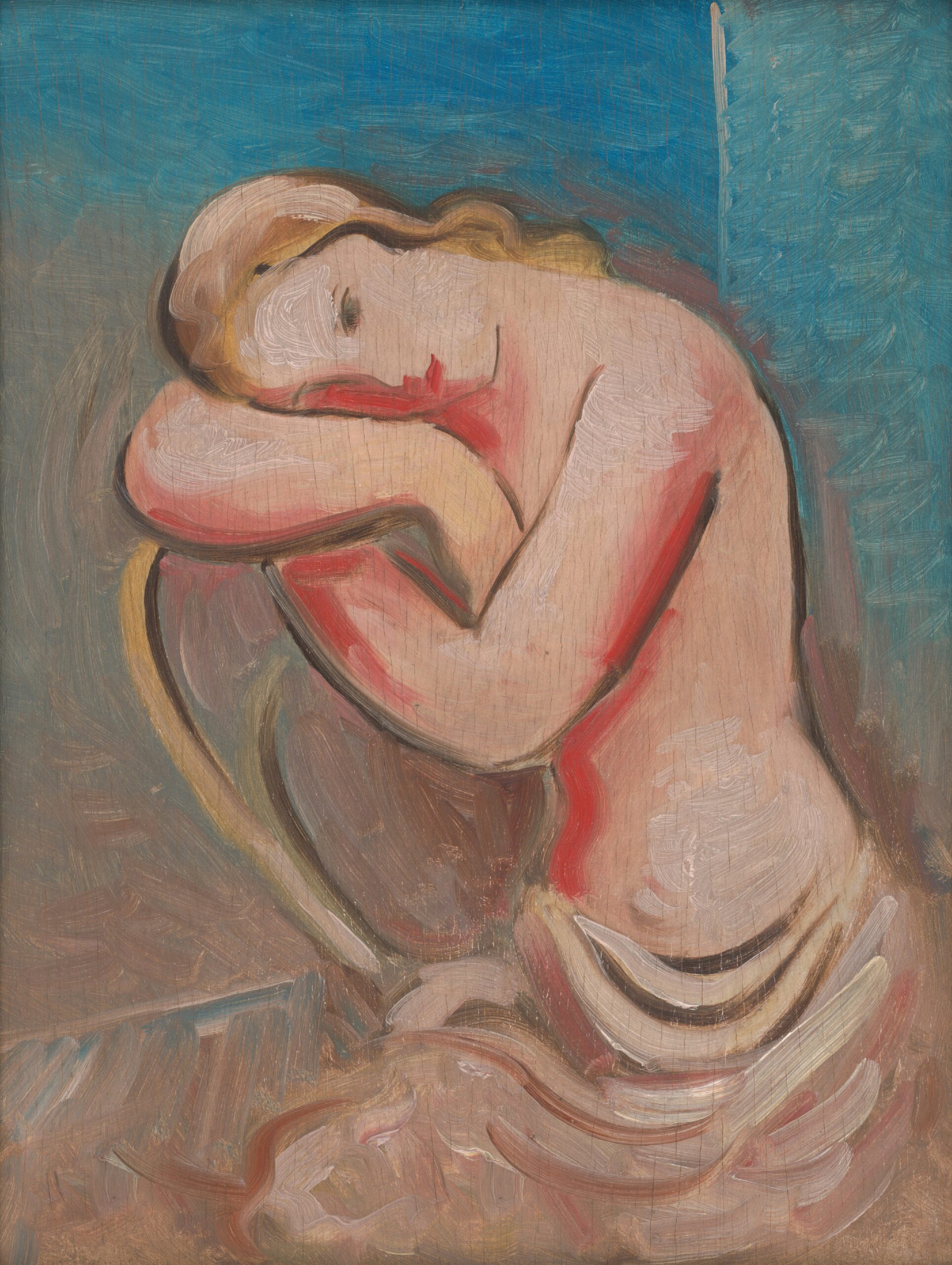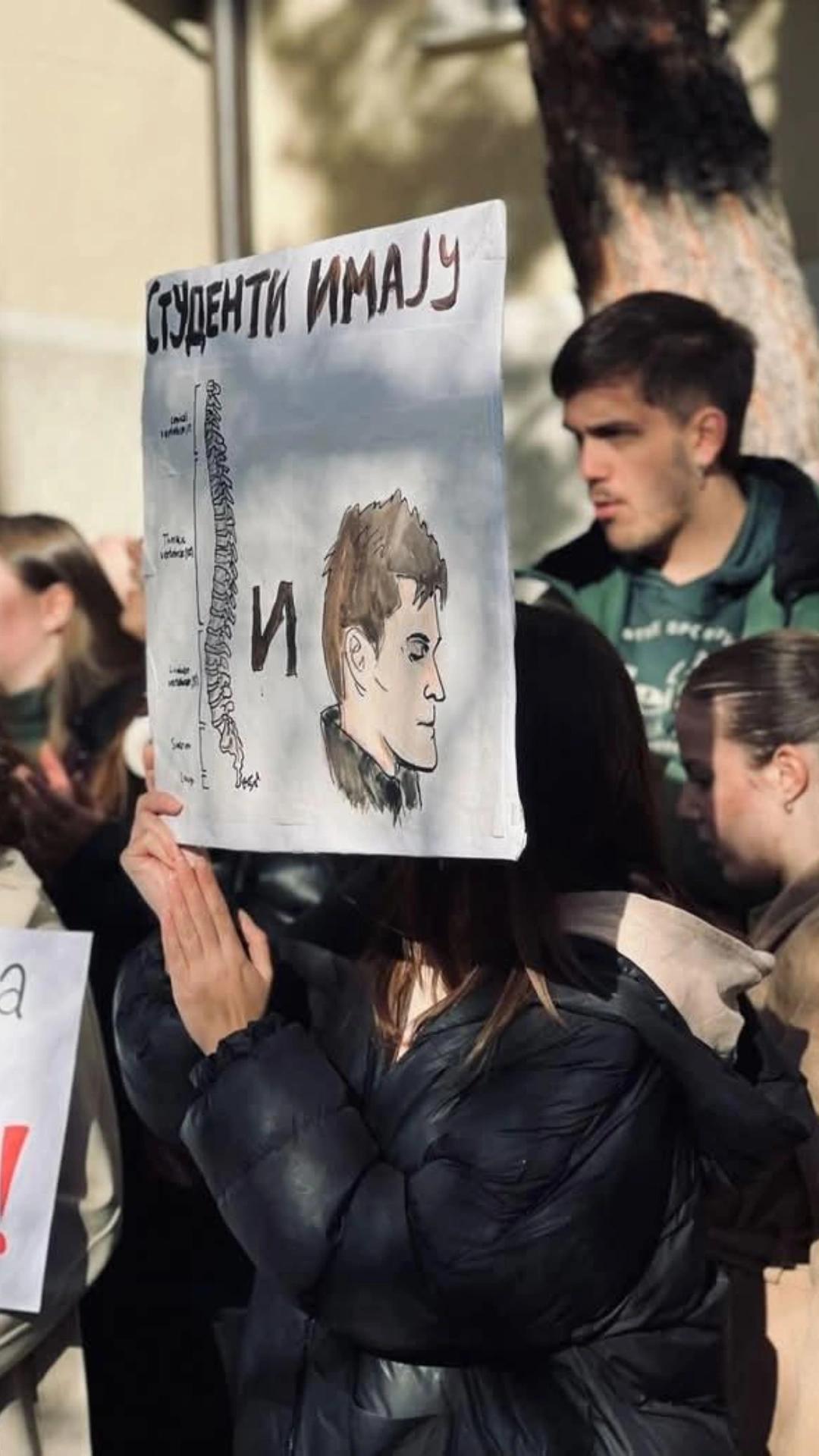
Clara Potts sat down with John Rainey to discuss his current exhibition Decoys & Ghosts, currently on view at Belfast’s Golden Thread Gallery. The conversation revealed a practice deeply invested in the aesthetics of disorientation, where imitation, fragmentation, and material transformation provoke queries into perception, identity, and historical narrative.
Working across Parian porcelain, 3D print, and now marble, Rainey constructs sculptures that blur the line between artefact and apparition, classical form and speculative fiction.
Rainey reflects on how his experience growing up in Northern Ireland, in a climate of ideological conflict and rigid social norms, continues to inform the emotional and political texture of his work.
In Decoys & Ghosts, Rainey doesn’t offer resolution. Plinths morph into creatures; surfaces wear borrowed skins; and figures emerge that seem to belong to an alternate lineage entirely. In other words, his shapeshifting and theatrical forms disrupt sculptural conventions and unsettle viewer expectations, inviting us to dwell in uncertainty and consider what might become possible when fixed meanings begin to unravel.
Clara: Your exhibition, Decoys & Ghosts delves into themes of imitation and revisiting. Could you elaborate on how these concepts manifest in your sculptures and what they signify within your broader artistic practice?
John: As concepts, decoys and ghosts are both connected to feelings of uncertainty and disorientation. They have the power to unsettle and make us question what’s real. That connected feeling of the familiar turning strange, where you can’t fully trust your own perception or the narratives you’ve been told, is one of the main themes I’m always returning to in my work. It’s not about tricking the viewer, but about creating an environment where questions emerge.
Much of my work involves reimagining familiar sculptural forms, presenting them in ways that disrupt the viewer’s expectations.
I often think of my sculptures as artefacts from an alternative reality, a space with different rules, where history unfolded differently. It’s a space where nothing is fixed, where the past bleeds into the present, and histories—both personal and collective—become fluid.
The title Decoys & Ghosts also resonates with the materials and processes I use. I work primarily with Parian porcelain, which was originally developed to mimic marble, to achieve a distinctive elegance. I push that illusion further by printing images of other materials onto its surface, letting it adopt different skins. The porcelain becomes an actor in a way, playing roles, wearing masks.
I cast the porcelain work using my large archive of plaster moulds. The moulds carry their own ghostly qualities – the way they hold the negative spaces of fragmented bodies, the hollow impressions of things that are no longer there. They’re like fossilised memories. The forms that I build using the mould archive are increasingly scrambled and disjointed, appearing almost like apparitions – elusive and otherworldly. I often revisit the same form again and again, each time building in new kinds of strangeness, and compounding the strangeness of previous versions.
Clara: You’ve been known to blend traditional casting techniques with digital fabrication. How do these methods interact in your current work, and what do they reveal about the relationship between classical forms and contemporary technology?
John: I began working with digital fabrication around 2010, which was a moment when online communication platforms were reshaping how we think about identity and representation. CAD software and 3D printing felt like appropriate tools to explore those ideas, and the work became an inquiry into digital representation—how identity exists, mutates, and circulates in virtual space.
Over time, these technologies have shifted from being a focal point to becoming more embedded in the early phases of my process, typically this involves editing and reconfiguring 3D scans of historical forms within CAD software. Working with these types of forms in the digital space has a certain freedom to it – many of the factors that define sculpture as a practice in the physical world, such as gravity, weight, and material limitations, are absent, and distortions and dramatic shifts in scale can occur with the touch of a button. It feels like a space to intervene in tradition, to test its boundaries, and there’s a lot of disruptive potential there.
But there’s always a return to the physical world, a re-embodying of these digital artefacts, reintroducing them into the tactile language and physical presence of materials. I feel like this back and forth between digital and physical spaces mirrors how we live our lives now—perpetually toggling between online and offline, screen and substance.
The forms re-enter the world as 3D prints which I subsequently use for casting. In the history of sculpture, casting was once a radical technology of reproduction—a way for forms to migrate, and to be seen elsewhere. Digital fabrication technologies feel like the next chapter in that story, expanding how classical forms can travel, transform, and be reinterpreted today.
Clara: The exhibition features installations where plinths evolve into diorama or viewing platforms. What inspired this approach, and how do you envision it affecting the viewer’s engagement with the sculptures?
John: Since my earliest exhibitions I always wanted my sculptures to exist in immersive environments. There’s a long-standing convention in sculpture, particularly ceramic sculpture, of the work sitting on a pristine white plinth, a very neutral stage. I felt an impulse to rethink or challenge that.
Over time, this has led to an evolution in the way my sculptures and their display structures interact. In Decoys and Ghosts, for example, the display furniture transforms into something more creaturely, almost architectural, blurring the line between object and environment. What began as an impulse to disrupt the plinth’s formal language has developed to a point where display structures begin to morph, sprout legs, and take on sculptural lives of their own.
This shift reconfigures the viewer’s relationship to the work. Rather than observing a sculpture as a discrete object, the audience steps into a designed experience—an immersive world that amplifies the framing of the sculptures as relics from an alternate culture or dimension. It becomes a kind of stage set – there’s a strong theatrical impulse to it, but also a commitment to crafting a specific tone, an atmosphere that envelops and disorientates.

Clara: You reimagine classical figures, sometimes incorporating animal forms or unexpected anatomical shifts. What draws you to these transformations, and what narratives or emotions are you aiming to evoke?
John: Transformation is a thread that runs through much of my work, but in Decoys and Ghosts, it takes on some new directions. There are pieces like Enchantment #2, which lands somewhere between human and animal form, and Oculus Venus, where the body starts to merge with architectural elements. I’m interested in how these shifts can unsettle expectations. It’s connected to the concept of shapeshifting and the notion of the carnivalesque—those spaces where conventional order gets turned upside down, and identities become more fluid. The anatomical shifts and hybrid forms suggest alternative states of being, spaces where social norms are less entrenched, where something looser or stranger might emerge. There’s emotion in that, a sense of curiosity, maybe freedom also.
Clara: Growing up in Northern Ireland during a period of significant social and political change, how have your personal experiences influenced the themes and aesthetics of your work, particularly in Decoys & Ghosts?
John: Some of the themes in the exhibition, disorientation and uncertainty for example, definitely relate to my experience of Northern Ireland. It’s a divided place with completely opposing narratives, and that’s disorientating. It took a period of living away from Northern Ireland to understand how deeply strange a lot of it is. I think my interest in art movements like Dada and Surrealism – the way they responded to the violence of WWI by disrupting logic, fragmenting the body, embracing the strange—is connected to the experience of growing up there too.
During that time in Northern Ireland social norms, particularly around gender roles and ideas about sexuality, were incredibly rigid. That pressure to conform, to fit a mould, left no room for complexity or difference. Decoys and Ghosts is in a way pushing back against that kind of rigidity—imagining bodies that shift and transform, that don’t fit neatly into predefined categories. That’s where a lot of the energy in the work comes from: imagining what else might be possible when boundaries are disrupted.
One of the ways in which I explore these ideas about possibility is by embracing a camp sensibility in the work. Camp isn’t just as an aesthetic – playful and deliberately excessive – but also a kind of resistance, a way of using humour and exaggeration to challenge authority, a way of undoing fixed meanings and critiquing oppressive systems. It creates a space where identity can be fluid and performative, as opposed to fixed and restricted.
Clara: Looking ahead, how do you see your exploration of imitation and revisiting evolving? Are there new materials or concepts you’re interested in integrating into your future projects?
John: The exhibition features one of my first sculptures in real marble, which feels like a meaningful shift. So much of my work with porcelain has played with mimicry—especially its ability to echo the appearance of more traditionally “noble” materials. But now, I’m less interested in any one material existing in isolation, and more in what happens when they’re placed in dialogue—when porcelain meets marble, for example, and the imitation confronts the original.
That contrast opens up a space for new questions—about authenticity, perception, and how value is assigned. What does it mean when the “fake” sits beside the “real,” and we’re no longer sure which one speaks louder? This idea of material disorientation is exciting to me. It allows for a richer exploration of illusion, hierarchy, and the cultural stories embedded in matter itself.
As with Decoys and Ghosts, these new explorations aren’t about offering conclusions. Instead, I’m building forms and spaces where contradictions can coexist, where beauty and strangeness coexist, and where viewers are invited not to decode, but to pause and dwell. To sit with things that unsettle us, and perhaps find something liberating there.
John Rainey’s exhibition, Decoys and Ghosts has been showing at Belfast’s Golden Thread Gallery from Saturday April 12th, and runs until Saturday June 7th.
For more information and opening times, visit:
https://goldenthreadgallery.co.uk/event/decoys-ghosts-john-rainey/
https://www.belfastcity.gov.uk/Events/Decoys-and-Ghosts-exhibition






